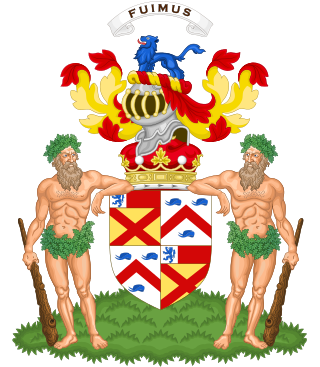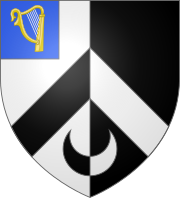
Earl Mountbatten of Burma is a title in the Peerage of the United Kingdom, created in 1947 for Rear Admiral Louis Mountbatten, who in 1946 had been created the first Viscount Mountbatten of Burma. He was later promoted to Admiral of the Fleet.

Earl of Longford is a title that has been created twice in the Peerage of Ireland.

Earl of Snowdon is a title in the Peerage of the United Kingdom. It was created in 1961, together with the subsidiary title of Viscount Linley, of Nymans in the County of Sussex, by Queen Elizabeth II for her then-brother-in-law, Antony Armstrong-Jones, who married Princess Margaret in 1960.

Duke of Fife is a title in the Peerage of the United Kingdom that has been created twice, in both cases for Alexander Duff, 1st Earl of Fife. In 1889, Lord Fife married Princess Louise, the eldest daughter of Albert Edward, Prince of Wales and a granddaughter of Queen Victoria.

Earl of Stockton is a title in the Peerage of the United Kingdom. It was created on 24 February 1984 for Harold Macmillan, the former Conservative prime minister, less than three years before his death in 1986. At the same time he received a subsidiary title Viscount Macmillan of Ovenden, of Chelwood Gate in the County of East Sussex and of Stockton-on-Tees in the County of Cleveland, also in the Peerage of the United Kingdom. The viscountcy is used as a courtesy title by the earl's heir apparent.
The Peerage of the United Kingdom is one of the five Peerages in the United Kingdom. It comprises most peerages created in the United Kingdom of Great Britain and Ireland after the Acts of Union in 1801, when it replaced the Peerage of Great Britain. New peers continued to be created in the Peerage of Ireland until 1898.

Marquess of Ailesbury, in the County of Buckingham, is a title in the Peerage of the United Kingdom. It was created on 17 July 1821 for Charles Brudenell-Bruce, 2nd Earl of Ailesbury.

Marquess of Linlithgow, in the County of Linlithgow or West Lothian, is a title in the Peerage of the United Kingdom. It was created on 23 October 1902 for John Hope, 7th Earl of Hopetoun. The current holder of the title is Adrian Hope.

Earl of Gowrie is a title that has been created twice, once in the Peerage of Scotland and once in the Peerage of the United Kingdom, both times for members of the Ruthven family. It takes its name from Gowrie, a historical region and ancient province of Scotland. On 23 August 1581, William Ruthven, 4th Lord Ruthven, was created Earl of Gowrie by James VI, King of the Scots. He was executed for high treason, attainted and his peerages forfeited on 28 May 1584. Two years later in 1586, the attainder was reversed and his son, the second Earl, was restored as Earl of Gowrie and Lord Ruthven, but both peerages were forfeited after the alleged plot and subsequent death of the second Earl's younger brother, the third Earl, in 1600.

Earl of Gosford is a title in the Peerage of Ireland. It was created in 1806 for Arthur Acheson, 2nd Viscount Gosford.

Earl of Limerick is a title that has been created twice in the Peerage of Ireland, associated first with the Dongan family, then with the Pery family. It should not be confused with the title Viscount of the City of Limerick held by the Hamilton family also Earls of Clanbrassil.

Earl of Normanton is a title in the Peerage of Ireland. It was created in 1806 for Charles Agar, 1st Viscount Somerton, Archbishop of Dublin. He had already been created Baron Somerton, of Somerton in the County of Kilkenny, in 1795 and Viscount Somerton, of Somerton in the County of Kilkenny, in 1800, also in the Peerage of Ireland. Lord Normanton sat in the House of Lords from 1800 to 1809 as one of the 28 original Irish Representative Peers.

Earl of Caledon, of Caledon in the County of Tyrone, is a title in the Peerage of Ireland. It was created in 1800 for James Alexander, 1st Viscount Caledon. He was a merchant who had made an enormous fortune in India. He also represented the constituency of Londonderry City in the Irish House of Commons. Alexander had already been created Baron Caledon in 1790 and Viscount Caledon, of Caledon in the County of Tyrone, in 1797, also in the Peerage of Ireland. In 1784, James Alexander purchased a city house in Dublin at Rutland Square where he lived when serving as an MP for Derry.

Earl Cathcart is a title in the Peerage of the United Kingdom.

Earl Jellicoe is a title in the Peerage of the United Kingdom. It was created, along with the subsidiary title Viscount Brocas, of Southampton in the County of Southampton, on 29 June 1925 for Admiral of the Fleet John Jellicoe, 1st Viscount Jellicoe, on his return from being Governor-General of New Zealand, with remainder to the heirs male of his body. He had already been created Viscount Jellicoe, of Scapa in the County of Orkney, on 15 January 1918, created with remainder to the heirs male of his body, and in default of such issue to his eldest daughter and the heirs male of her body, with the like remainder in default of such issue to every other daughter successively in order of priority of birth, and to the heirs male of their bodies. The Jellicoe viscountcy was created with remainder to his daughters and their heirs male because, at the time of the creation, Jellicoe had five daughters and no sons. His only son was born three months later.

Earl of Stradbroke, in the County of Suffolk, is a title in the Peerage of the United Kingdom. It was created in 1821 for John Rous, 1st Baron Rous, who had earlier represented Suffolk in the House of Commons.

Earl of Selborne, in the County of Southampton, is a title in the Peerage of the United Kingdom. It was created in 1882 for the lawyer and Liberal politician Roundell Palmer, 1st Baron Selborne, along with the subsidiary title of Viscount Wolmer, of Blackmoor in the County of Southampton. He had already been made Baron Selborne, of Selborne in the County of Southampton, in 1872, also in the Peerage of the United Kingdom. Both his son, the second Earl, and grandson, the third Earl, were prominent Liberal Unionist politicians. The latter was in 1941 called to the House of Lords through a writ of acceleration in his father's barony of Selborne. The third Earl's grandson, the fourth Earl, served as one of the ninety elected hereditary peers that remain in the House of Lords after the passing of the House of Lords Act 1999, and sat as a Conservative. As of 2021, the titles are held by the latter's son, the fifth earl, who succeeded his father in that year.

Viscount Bridgeman, of Leigh in the County of Shropshire, is a title in the Peerage of the United Kingdom. It was created in 1929 for the Conservative politician William Bridgeman, who had previously served as Home Secretary and First Lord of the Admiralty. He was the son of Reverend John Robert Orlando Bridgeman, third son of George Bridgeman, 2nd Earl of Bradford. His son, the second Viscount, served as Lord Lieutenant of Shropshire from 1951 to 1969. As of 2014 the title is held by the latter's nephew, the third Viscount, who succeeded in 1982. He is one of the ninety elected hereditary peers that remain in the House of Lords after the passing of the House of Lords Act 1999, and sits as a Conservative.

Baron Ravensdale, of Ravensdale in the County of Derby, is a title in the Peerage of the United Kingdom. It was created in 1911 for the Conservative politician George Curzon, 1st Baron Curzon, of Kedleston, who had previously served as Viceroy of India.
Shane William Desmond Alexander, 2nd Earl Alexander of Tunis, styled Lord Rideau between 1952 and 1969, is a British hereditary peer.










